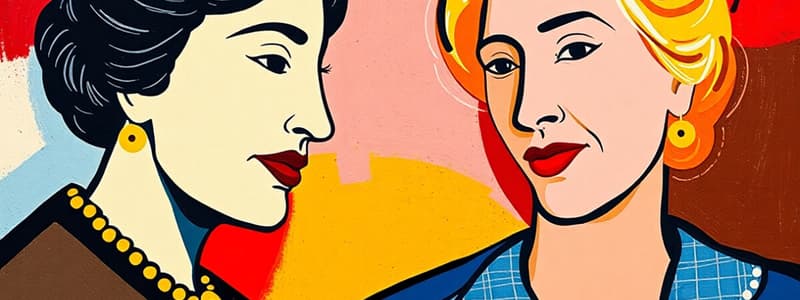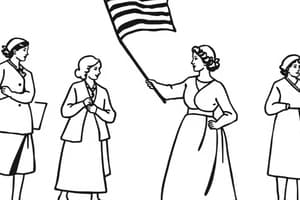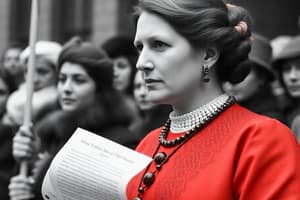Podcast
Questions and Answers
What was the main reason Woodrow Wilson initially opposed the women's suffrage amendment?
What was the main reason Woodrow Wilson initially opposed the women's suffrage amendment?
- He was concerned it would alienate his political base and hurt his chances of reelection (correct)
- He favored a gradual approach to women's rights and felt the amendment was too radical.
- He believed the amendment was unnecessary, as women already had equal rights to men.
- He believed women were not capable of making informed decisions about politics.
Which state played a crucial role in the passage of the 19th Amendment, securing women's right to vote?
Which state played a crucial role in the passage of the 19th Amendment, securing women's right to vote?
- Massachusetts
- Tennessee (correct)
- California
- New York
What ultimately convinced Woodrow Wilson to support the women's suffrage amendment?
What ultimately convinced Woodrow Wilson to support the women's suffrage amendment?
- He changed his mind after witnessing the passionate activism of suffragettes.
- He believed it was a necessary measure to ensure equality for all Americans.
- He was pressured by his cabinet to support the amendment.
- He realized the amendment was critical to winning World War I. (correct)
What was the main reason why the women's suffrage movement took so long to achieve its goal?
What was the main reason why the women's suffrage movement took so long to achieve its goal?
Which of the following groups did NOT gain the right to vote until after women were granted suffrage in 1920?
Which of the following groups did NOT gain the right to vote until after women were granted suffrage in 1920?
Which of the following is NOT a testament to the persistence and determination of the women's suffrage movement?
Which of the following is NOT a testament to the persistence and determination of the women's suffrage movement?
What is the significance of the fact that Tennessee was the deciding state for the passage of the 19th Amendment?
What is the significance of the fact that Tennessee was the deciding state for the passage of the 19th Amendment?
Which of these actions was NOT employed by the women’s suffrage movement to achieve their objective?
Which of these actions was NOT employed by the women’s suffrage movement to achieve their objective?
What was one of Parker Pillsbury's key beliefs regarding women's rights?
What was one of Parker Pillsbury's key beliefs regarding women's rights?
What significant role did Frederick Douglass play in the women’s suffrage movement?
What significant role did Frederick Douglass play in the women’s suffrage movement?
What was the 'bloomer costume' popularized by Amelia Jenks Bloomer?
What was the 'bloomer costume' popularized by Amelia Jenks Bloomer?
What was a major outcome of Parker Pillsbury's activism?
What was a major outcome of Parker Pillsbury's activism?
How did Victoria Woodhull's family background influence her life?
How did Victoria Woodhull's family background influence her life?
What was the first newspaper founded by Amelia Jenks Bloomer focused on?
What was the first newspaper founded by Amelia Jenks Bloomer focused on?
Which event did Frederick Douglass attend that was crucial to women's rights?
Which event did Frederick Douglass attend that was crucial to women's rights?
What was Inez Milholland Boissevain's role in the suffrage movement?
What was Inez Milholland Boissevain's role in the suffrage movement?
What practice did many suffragists adopt from Amelia Jenks Bloomer?
What practice did many suffragists adopt from Amelia Jenks Bloomer?
How did Alice Paul contribute to the suffrage cause?
How did Alice Paul contribute to the suffrage cause?
What did Charlotte Woodward Pierce advocate for?
What did Charlotte Woodward Pierce advocate for?
Flashcards
Who was Frederick Douglass?
Who was Frederick Douglass?
A formerly enslaved man who spoke out for women's suffrage, comparing their situation to enslaved people.
What was The Revolution?
What was The Revolution?
An influential newspaper dedicated to women's rights that was co-edited by Parker Pillsbury.
What were Parker Pillsbury's views on women's rights?
What were Parker Pillsbury's views on women's rights?
A man who believed that men should use their power to empower women and fought against the idea that men were protecting women.
What was the founding document of the American Equal Rights Association?
What was the founding document of the American Equal Rights Association?
Signup and view all the flashcards
What is the "bloomer costume"?
What is the "bloomer costume"?
Signup and view all the flashcards
What was The Lily?
What was The Lily?
Signup and view all the flashcards
Who was Victoria Woodhull?
Who was Victoria Woodhull?
Signup and view all the flashcards
Who are the nameless activists in the fight for women's suffrage?
Who are the nameless activists in the fight for women's suffrage?
Signup and view all the flashcards
Women's Suffrage Movement
Women's Suffrage Movement
Signup and view all the flashcards
Declaration of Sentiments
Declaration of Sentiments
Signup and view all the flashcards
Seneca Falls Convention
Seneca Falls Convention
Signup and view all the flashcards
Women's March in NYC
Women's March in NYC
Signup and view all the flashcards
Constitutional Amendment
Constitutional Amendment
Signup and view all the flashcards
Picketing the White House
Picketing the White House
Signup and view all the flashcards
Tennessee
Tennessee
Signup and view all the flashcards
Fight for Voting Rights
Fight for Voting Rights
Signup and view all the flashcards
Who was Josephine St.Pierre Ruffin?
Who was Josephine St.Pierre Ruffin?
Signup and view all the flashcards
How did Nina Evans Allender contribute to the suffrage movement?
How did Nina Evans Allender contribute to the suffrage movement?
Signup and view all the flashcards
Who was Alice Paul?
Who was Alice Paul?
Signup and view all the flashcards
How did Inez Milholland Boissevain impact the suffrage movement?
How did Inez Milholland Boissevain impact the suffrage movement?
Signup and view all the flashcards
How did Alice Snitjer Burke and Nell Richardson promote suffrage?
How did Alice Snitjer Burke and Nell Richardson promote suffrage?
Signup and view all the flashcards
Why was Harry T. Burn significant to the suffrage movement?
Why was Harry T. Burn significant to the suffrage movement?
Signup and view all the flashcards
What was Charlotte Woodward Pierce's role in women's rights?
What was Charlotte Woodward Pierce's role in women's rights?
Signup and view all the flashcards
Study Notes
Historic Figures and Activism
- Countless individuals fought for women's rights, but many remain nameless.
- Some suffragists are famous for a single act or moment in their lives.
- Others have significant contributions to women's rights but are overlooked due to prejudice.
- Many historical figures' well-known accomplishments overshadow their suffrage activism.
Parker Pillsbury
- Parker Pillsbury was a man who supported women's rights in the 19th century.
- He advocated for women's suffrage and believed men had a responsibility to empower women.
- He was ahead of his time, drafting the founding document of the American Equal Rights Association in 1865.
- His activism was costly, impacting his career and personal life.
Frederick Douglass
- Frederick Douglass understood the injustices of slavery and supported women's rights.
- He was invited to speak at the Seneca Falls Convention, where he advocated for women's right to vote.
- He strongly believed that denying women the vote was a similar form of oppression as slavery.
- He published the Declaration of Sentiments word for word in his paper, "The North Star".
Amelia Jenks Bloomer
- Amelia Bloomer advocated for women's clothing reform in the 19th century.
- She created the "bloomer costume," loose pants and a tunic, designed for comfort and practicality.
- She played a role in introducing women's suffrage ideas.
- She introduced Elizabeth Cady Stanton and Susan B. Anthony, two key figures in the women's suffrage movement.
Victoria Woodhull
- Victoria Woodhull was a notable figure in the 19th century, advocating for women's rights and suffrage.
- She faced significant challenges from her childhood, including an abusive father and poverty, although she became a successful business woman.
- She was publicly accused by another women's rights supporter, which created controversy.
- She was a candidate for President before women could vote.
Josephine St. Pierre Ruffin
- Josephine was a key figure in the suffrage movement, and she founded the first national African-American women's club.
- She believed in cross-group cooperation for women's rights.
Nina Evans Allender
- Nina Evans Allender was an artist who used her talents to raise awareness for the suffrage movement.
- She created memorable images and cartoons to support the cause.
- She highlighted the struggles and inequalities faced by women in a visually engaging way.
Inez Millholland Boissevain
- Inez Millholland Boissevain was a strong advocate for women's suffrage.
- She was a leader in parades and demonstrations for women's right to vote.
- She died from pernicious anemia while advocating for women's rights, becoming a martyr for the cause.
Nell Richardson and Alice Snitjer Burke
- Nell Richardson and Alice Snitjer Burke were key figures who highlighted the role of women in early 20th-century automobiles.
- They took a significant road trip to advocate for women's suffrage and travel across the country by car.
Alice Paul
- Alice Paul is notable for her role in the women's suffrage movement
- She designed the famous "Jailed for Freedom" suffrage pin.
- She played a significant role in the Prison Special, a train tour that drew attention to the issues faced by jailed suffragists.
Charlotte Woodward Pierce
- Charlotte Woodward Pierce was a vocal suffragist and was involved in the Seneca Falls Convention.
- She demonstrated a strong commitment to women's rights and suffrage.
- She supported the women's suffrage movement throughout her life, participating in marches and rallies.
Harry T. Burn
- Harry T. Burn was a key figure in the Tennessee ratification of the Nineteenth Amendment.
- His vote effectively secured the passage of the amendment.
- He was a reluctant supporter of suffrage, ultimately changed his vote at his mother's request.
Suffragist Julia Emory and Bertha Graf
- Suffragists Julia Emory and Bertha traveled from Washington, D.C. to Marion, Ohio for demonstrations in support of women's suffrage.
Epilogue
- The fight for women's suffrage was long and sometimes overlooked.
- The opposition faced criticism and delay tactics from various groups.
- Finally, women secured the right to vote after facing considerable political, social and economic opposition.
- Even after the right to vote was established, access to the polls and voting rights continued to be challenged for many demographics.
Studying That Suits You
Use AI to generate personalized quizzes and flashcards to suit your learning preferences.




